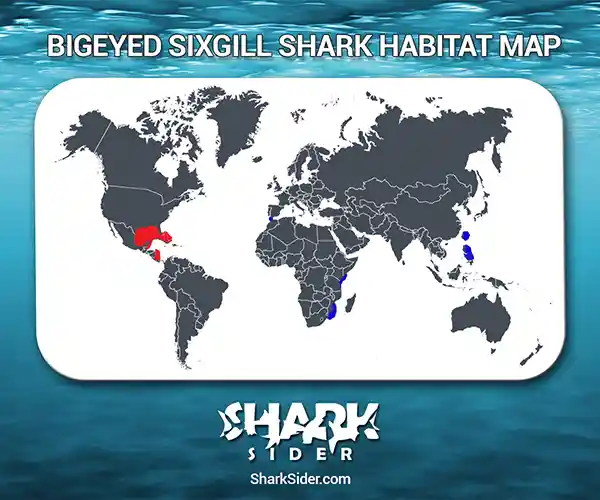The Bigeyed sixgill shark is native to the Western Pacific, Atlantic, and Indian oceans. They are unique because of their six gill slits compared to the five in most other species.
These sharks play host to several parasites, including flatworms such as Protocotyle euzetmaillardi, on the gills of specimens from the South Pacific Ocean. Larger sharks are likely to prey upon them.
Bigeyed Sixgill Shark Scientific Classification |
|
| Kingdom | Animalia |
| Phylum | Chordata |
| Class | Chondrichthyes |
| Order | Hexanchiformes |
| Family | Hexanchidae |
| Genus | Hexanchus |
| Scientific name | H. nakamurai |
Description
These sharks are moderately sized, averaging 120 cm (4 ft) for both genders and weighing around 20 kg (44 pounds). The largest specimens grow to 180 cm (6 ft).
They have brownish-grey upper bodies, contrasting sharply with their pale lower half. Their bodies are slim and spindle-like, with a blunt, pointed snout, a narrow, flat head, and fluorescent green eyes. They have five rows of long, comb-like teeth and six gill slits.
They have white-tipped fins, with the upper caudal tip colored black in juveniles. The single dorsal fin is behind the pelvic fins, near the origin of the tail. The upper caudal fin is much more prominent than the lower one, having a deeply notched tip.
Where do they live
Map Of The Bigeyed Sixgill Shark’s Habitat

This species has a patchy global distribution in tropical and temperate climates. In the Atlantic, it inhabits Mexico, the Bahamas, Nicaragua, northern Cuba, and Costa Rica in the west. In the east, it occurs from France to Morocco, including the Mediterranean Sea, and perhaps Côte d’Ivoire and Nigeria. In the Indian Ocean, it lives on the eastern and southern African coast and Aldabra Island of India. It is found in Japan, Taiwan, the Philippines, eastern Australia, and New Caledonia in the Western Pacific.
They inhabit the continental and insular slopes near the ocean floor at depths of 90-600 m (295-1,970 ft). They are generally deepwater sharks but can move toward the surface at night to feed and avoid abyssal regions.
Behavior
Dietary
Its dietary habits need more research. Analysis of the stomach remains suggests that they mainly hunt small to medium-sized crustaceans and bony fish.
Reproductive
Like all other members of its genus, this shark follows an ovoviviparous mode of reproduction. The females have up to 13 young in a single litter, measuring 40-45 cm (1.3-1.5 ft). They become sexually mature at 120-160 m (4-5.2 ft) for males and 142-178 cm (4.7-5.8 ft) for females.
Adaptations
They share many standard features with other sharks, such as a sharp sense of smell and vision, smooth, streamlined bodies, and pointed teeth.
Human interactions
According to the International Shark Attack File, these sharks are harmless and never attack humans as their habitats are away from human settlements. They have little commercial use, and trawlers and longlines may sometimes catch them. If caught, they may be used for their meat, fins, and liver oil. Their populations are stable, yet the IUCN has classed them as “Near Threatened” or “NT” due to increasing pressure from commercial fisheries.
